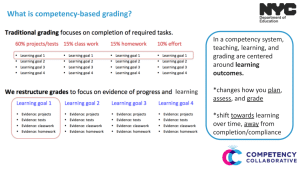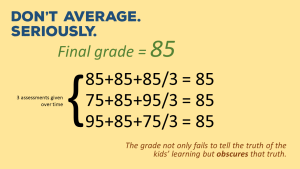CBE in Practice: Grading
CompetencyWorks Blog
Lots has been written about competency-based grading at CompetencyWorks throughout the years (see below for a short sampling). As I settled into my role this summer, I had the opportunity to observe two professional learning sessions on grading practices with the Competency Collaborative in NYC and with the Great Schools Partnership (GSP). This post curates resources for those who want to reflect on how grading practices in your setting are aligned — or misaligned — to the values of learner-centered, competency-based education. It supplements the CBE Starter Pack post 2 on meaningful assessment.
Grading and Reporting

It is important to note the distinction between grading and reporting. Grading and reporting touch multiple levels of the system. It is worth taking the time to define what we are talking about. GSP offers the following definitions:
- Grading System: The system that a school has developed to guide how teachers assess and grade student work.
- Reporting System: The system that a school has developed to communicate student grades formally on report cards and transcripts
Grading and reporting closely interconnect. Here we will focus more on the grading system, which is the foundation of the information that is then reported.
Grading and Equity
As a system, CBE is intentionally designed to be equity-seeking, including in grading practices. Grading for equity has also become a standalone educational change lever, largely due to Joe Feldman’s book, Grading for Equity: What It Is, Why It Matters, and How It Can Transform Schools and Classrooms, which was used as a key resource in both sessions I observed. While the book is not explicitly about CBE practices, many of the topics align with CBE topics such as learners developing agency to lead their own learning, transparency in how to succeed, authentic assessment, and having multiple opportunities to demonstrate learning and growth.
Are Grading Practices a Keystone Issue?
Over the years, various practitioners and technical assistance providers have often advised not to start transformation efforts by changing the reporting system. After all, how can you report on competencies before you have implemented them? But could classroom grading practices actually be a viable entry point into CBE?
At some point in your process of transformation, you will need to examine and reflect on how student work is assessed and graded.
- How clearly do grades in your classroom or at your school communicate whether students have learned the learning goals?
- How clear are the learning goals?
- What happens if a student needs more time to learn and practice a topic or a skill?
Reflecting on grading practices might have the ideal mix of a) surfacing the flaws, inequities, and harm of predominant, status quo practices; b) connecting us to our values to prompt the adaptive mindset work we know is needed in change work; and c) presenting opportunities to pilot small, practical, research-based changes.
The Power of Grades
NYC’s Competency Collaborative’s Summer Institute on Reigniting Student Motivation Day 3 focused on Establishing Supportive and Equitable Grading Practices. While on the surface we might think of grades only as an objective signal of how a student is doing in school, the research shows that grades have a far-reaching impact. Grades are communication, and we need to think about what they are communicating to students — is it about their learning or is it about something else? The session showed that grades also affect students’:
- Learning identities (belonging mindset)
- Feelings of worth, capability, agency (growth mindset)
- Connection to or alienation from academics — and school generally (belonging and value mindset/purpose for learning)
A vision for grades at their best was offered: that grades are “accurate, supportive, bias-resistant feedback based on evidence of what a learner knows and can do at a given point in time.” A similar vision was offered in the GSP session (and on the GSP website), that the “purpose of the grading system is to clearly, accurately, consistently and fairly communicate learning progress and achievement to students, families, post-secondary institutions, and prospective employers.”
What is Competency-Based Grading?
The GSP Grading for Equity workshop offered the following core tenets for equitable school grading and reporting practices:
- Communicate Information About Learning
- Design Clear Grading & Reporting Guidelines
- Use Common Rubrics or Scoring Guides
- Provide Low-Stakes Practice & Feedback
- Report on Habits of Work Separately
- Organize Grade Books Consistently
The Competency Collaborative has a webpage on competency-based equitable grading and the following slide in their session illustrated how equitable, competency-based grading practices might change from traditional, status quo practices.

The session offered a list of key practices for equitable grading that also drew from Feldman’s work.
- Use a 0-4 or 1-4 scale.
- Don’t grade cross-cutting skills / habits of work. Do give feedback on these habits and skills.
- Base grades on evidence of learning.
- Give multiple opportunities.
- Base grades only on where a learner is with learning outcomes.
- No “points off” for missing deadlines or cheating. (Avoid using grades as punishments.)
- No added points for effort, extra credit, and other non-evidence factors.
- Transparency. Share (unpack, revise, put in student-friendly language) course outcomes from the start.
- Disaggregate skills, and don’t average multiple outcomes.
- Connect feedback to learning outcomes.
- Use growth mindset language. “Not yet” “Approaching” “Developing” “Emerging”

How do we get started in talking about grading?
These ideas may already be infused into your school’s or district’s culture and practices. If so, I hope you will share your journey with someone and help them get started. Or, you may be at the beginning of your journey. Read on for a few big ideas and resources to get started.
There is a range of approaches to CBE grading and reporting systems. For example, there are fully portfolio- or competency-based systems and there are systems that convert proficiency on standards or competencies into traditional grades only for reporting purposes. Making the shift to a competency-based reporting system can be a complicated one. Even if it feels like your community isn’t ready to shift reporting systems, reflecting on grading practices at the classroom level can and should start sooner. Creating a consistent, equitably oriented philosophy and set of guidelines can be a great entry point for mindset work.
Grading practices can seem like tough territory to tackle. However, if you don’t have consistent practices and a shared philosophy, it’s likely that grades are sending mixed messages to students and families. It’s also likely that there are equity issues that need to be considered and addressed — whether they are blind spots or intentionally ignored.
Learn More
There are many resources on the topic of competency-based grading and grading for equity. Here are a few to get started.
Deeper Resources
- The Issue Brief, Progress and Proficiency: Redesigning Grading for Competency Education, can help districts and schools converting to competency-based education develop new philosophies of grading, as well as the specific practices needed to operationalize them.
- The report Vermont Proficiency-Based Grading Practices provides examples of current grading and reporting practices that help innovative schools and districts support each other’s success. It offers explanations that can help staff and families understand unfamiliar practices.
Blog Posts and Articles
- The three-part blog series by Rose Colby explores Building Coherent Grading and Reporting Systems in Competency-Based Education (Part 1) (and Part 2, Part 3).
- This blog post, AASA Explores Competency-Based Education Grading, summarizes an issue of the AASA Administrator about “performance-based grading” with articles on secondary school grading, standards-based grading and college admissions, and an overview of Lindsay Unified’s change process.
- The article, Making Grades More Meaningful, offers a glimpse into the change process in Jefferson County, KY.
- An article by Thomas Guskey, Five Obstacles to Grading Reform, outlines five long-held traditions that stand as formidable obstacles to change.
- A recent article on EducationNext asks, “Time to Pull the Plug on Traditional Grading?”
Videos and Podcasts
- A three-minute video by the Competency Collaborative titled Why make the shift to mastery-based learning? features two NYC high schools, KAPPA International High School and Urban Assembly Maker Academy.
- A 30-minute podcast interview with Joe Feldman on the Harvard EdCast about Grading for Equity.
- This #Aurora2020 Symposium Session with GSP explores Grading and Reporting for Educational Equity.
- A video with Todd Rose on The Myth of Average challenges our ideas about how we think about average.
- This KQED MindShift 30-minute podcast (with transcript) asks Grades Have Huge Impact, But Are They Effective?
Organizations
- The Mastery Transcript Consortium is working at the systems level to rethink transcripts.
- The Modern Classroom Project is a practical approach that includes both mastery-based grading and blended learning through flipped instruction. It started with the classroom practice of the founder when he was a teacher.
Laurie Gagnon is the Aurora Institute’s CompetencyWorks Program Director.